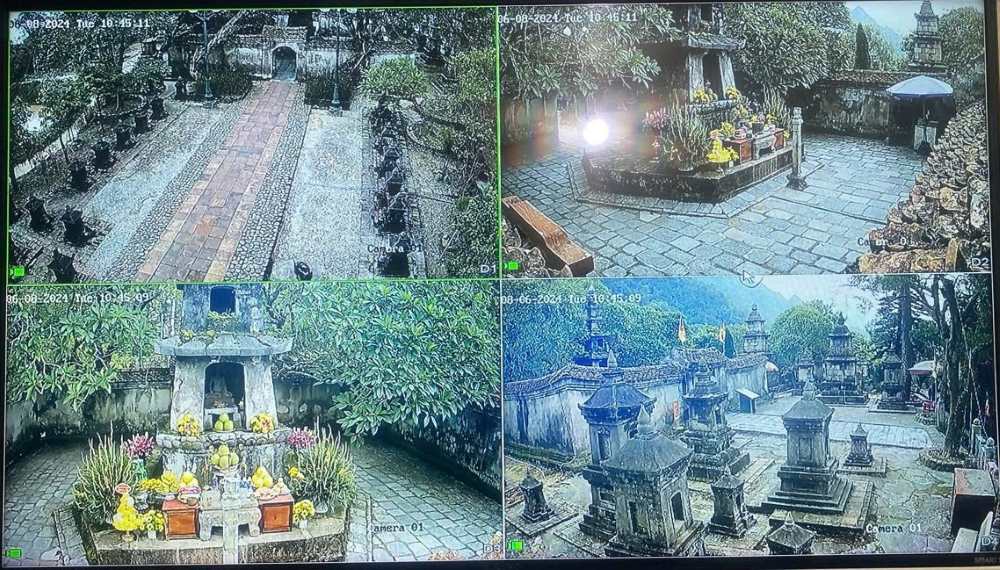12 other national treasures are currently being managed, serving visitors to visit and learn at the Quang Ninh Museum.
The Buddha statue is placed in the examining floor of Hue Quang tower (commonly known as the To Tower), Hoa Yen pagoda, belonging to a special national relic - Yen Tu relic site, Uong Bi city, Quang Ninh province.
Hue Quang Tower was built by King Tran Anh Tong to honor the reign of King Tran Nhan Tong in 1326. This tower was once collapsed, and was restored and rebuilt during the Le Trung Hung Dynasty (17th century).
The statue of King Tran Nhan Tong has also been carved and decorated in the tower since then. Despite more than 300 years of existence, with many ups and downs in history, the statue is still well preserved.

The statue consists of two parts: A pedestal and a body, with an overall height of 83.8cm. The statue is carved in a recess, semi-compass seated position, with the left foot placed on the right thigh and the sole of the foot resting up.
The statue is shown with a delicate face, large ears, wide forehead, high neck with many delicate figures. The shirt lines and pants are arranged softly and gracefully; the patterns on the shirt and pants are detailed and sharp. On the statue, in addition to the lines showing the winding lines of the costume showing the sophistication of the sculptor, the decorative motifs on the canvas of the Chinese and Chinese bears and Chinese bears show the aesthetics, ideological meaning and enhance the value of the statue.
The statue is placed on a rectangular pedestal like a "falling knee to the fish". The collapse consists of two parts, the square surface above is raised like the "Group". The front of the platform is divided into 5 compartments, 2 compartments on the outside are arranged in a square structure, the center is decorated with a lotus flower on a leafline, the middle compartment is a square compartment decorated with lotus flowers and 2 compartments on both sides, interspersed between the middle compartment and the outer compartment with a dragon and a gourd decorated with lotus flowers in the middle. The sides create rectangular holes, the middle decorated with lotus flowers, the back is for plain clearance.
The statue of King Tran Nhan Tong is a typical example of the model in the sculpture of the Buddha Dai Viet statue in the 17th century. The cloud motifs are arranged in a dragon-shaped project, behind the dragon head are cloud strips extending into knives. The motifs and projects of the lotus on the media, the lower media and the lotus flowers on the platform are consistent in style, structure and expression. The lotus and passion fruit project on traditional costumes is often found on stele and worship statues during the Le Trung Hung Dynasty.
According to experts, King Tran Nhan Tong is worshiped in many places, in two main forms: the throne and the worship statue, but the statue of King Tran Nhan Tong at Hue Quang tower, Hoa Yen pagoda is not like any other statue in terms of pose, charm, decorative motifs and even appearance. Therefore, it can be affirmed that the statue of King Tran Nhan Tong at Hue Quang tower, Hoa Yen pagoda is a unique artifact.
According to Mr. Le Tien Dung - Head of the Management Board of Yen Tu National Park and Forest, every day, thousands, even tens of thousands of visitors visit Hue Quang tower garden, burning incense in front of the statue of King Tran Nhan Tong.

In addition to the good awareness of tourists and monks and Buddhists, the unit also regularly arranges personnel to guide people during the ceremony and be on duty day and night to guard and protect the national defense.
Here, the unit also installed a 4-eyed camera system, connecting with the Yen Tu National Park and Forest Management Board to monitor and supervise day and night.
According to Mr. Do Quyet Tien - Director of Quang Ninh Museum, the unit does not manage the national treasure of the Buddha statue of Tran Nhan Tong, but also shares a signal directly from the scene about a large screen in the fixed exhibition area to serve visitors.








